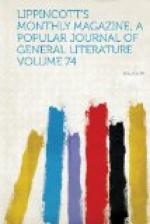“Fine arguments, truly! You shall sleep to-night in Paris, or even at Marly, if you see fit. I have often heard you argue against railroads—a fine argument for a geographer to uphold against an engineer! Now is the instant to bury your prejudice. Do you see that soft ringlet of smoke off yonder? It is the message of the locomotive, offering to reconcile your engagements with Grandstone and Hohenfels. Come, get your ticket!”
[Illustration: Boursault, the residence of Cliquot.]
And his hand ceased squeezing my shoulder like a pincer to beat it like a mallet. A rapid sketch of the situation was mapped out in my head. I could reach Epernay by five o’clock, returning at eight, and, notwithstanding this little lasso flung over the champagne-country, I could resume my promenade and modify in no respect my original plan; and I could say to Hohenfels, “My boy, I have popped a few corks with the widow Cliquot.”
Such was my vision. The gnomes of the railway, having once got me in their grasp, disposed of me as they liked, and quite unexpectedly.
From the car-window, as in a panorama of Banvard’s, the landscape spun out before my eyes. Le Raincy, which I had intended to visit at all events on the same day, but afoot, offered me the roofs of its ancient chateau, a pile built in the most pompous spirit of the Renaissance, and whose alternately round and square pavilions, tipped with steep mansards, I was fain to people with throngs of gay visitors in the costume of the grand siecle. Then came the cathedral of Meaux, before which I reverently took off my cap to salute the great Bossuet—“Eagle of Meaux,” as they justly called him, and on the whole a noble bird, notwithstanding that he sang his Te Deum over some exceedingly questionable battle-grounds. Then there presented itself a monument at which my engineering friend clapped his hands. It was a crown of buildings with extinguisher roofs encircling the brow of a hill, and presenting the antique appearance of some chastel of the Middle Ages.
[Illustration: Church-door, Epernay.]
“Do you see those round, pot-bellied towers, like tuns of wine stood upon end?” he said—“those donjons at the corners, tapering at the top, and presenting the very image of noble bottles? There needs nothing but that palace to convince you that you have arrived in the champagne region.”
“I do not know the building,” I confessed.
“Can you not guess? Ah, but you should see it in a summer storm, when the rain foams and spirts down those huge bottles of mason-work, and the thunder pops among the roofs like the corks of a whole basket of champagne! That fine castle, Flemming, is the chateau of Boursault, apparently built in the era of the Crusades, but really a marvel of yesterday. It rose into being, not to the sound of a lyre, like the towers of Troy, but at the bursting of innumerable bottles, causing to resound all over the world the name of the widow Cliquot.”




